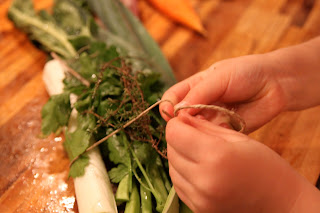As promised, I am going to revisit the environmental issues that surround animal husbandry with a particular focus on water.
Before we proceed any further, I have to digress a bit into the field of water chemistry, but don't worry, I'll keep this simple.
Water is "clean" when the ecosystem that lives in it thrives. This
ecosystem requires nutrients, which at the most basic level are carbon,
nitrogen, and phosphorus (C, N, P). Under normal conditions, bacteria
and algae will oxidize these chemicals to grow. As you might have
noticed, bacteria are not known for being braniacs and so they'll eat
and multiply until they run out of something, be it nutrients or oxygen.
At the simplest level, one of the ways in which water becomes "dirty" or "polluted" is when
there is so much C, N, P in it that the bacteria and algae consume all
of the oxygen, leaving none - or not enough - for the fish or the rest
of the ecosystem. To take it slightly further, the ecosystem can be severely harmed by the
intrusion of excess C, N, P, even if not all oxygen is consumed. Some
organisms, like trout, require a minimum level of oxygen in water to
thrive.
This leads to our first equation :
C, N, P + WATER = POOWATER
There are plenty of sources of C, N, P in this world, including fertilizers, among others. So this wouldn't necessarily concern our meat eating ethics except that there is a second equation:
POO = C, N, P
Those who paid attention in math will know that we can combine these equations to reach this brilliant conclusion (Nobel committee, are you paying attention?):
POO + WATER = POOWATER
That's right, when a cow, a pig, a chicken, a human etc... poos in water, the water gets dirty, and now we have mathematical proof! Thanks to the utter brilliance of the above equation - brilliant because it also works with pee - you now know why it's bad that livestock to poos in water. Aren't you glad you made it this far? Besides C, N, P, poo also contains suspended solids, antibiotics/hormones (if given to the animals), and
fecal coliform, all of which are also bad for the environmental health of water and can be directly harmful to humans.
As is often the case, the amount of damage caused by livestock poo is directly related to the amount of poo as compared to the size (and other physical characteristics) of the receiving water body - river, lake, pond, estuary, groundwater, etc...
To illustrate: 1000 cows pooing on a mile or river means an environmental disaster whereas 1 cow pooing on 1000 miles of river means some happy algae.
Anybody who's been to the country knows that livestock isn't toilet trained, and will tend to relieve themselves wherever they please, which can very much include right on your shoes. So the next question we must answer is: how does poo go from the fields to the river?
The answer is a simple phenomenon called runoff. When it rains, the rainwater runs off the ground and into rivers, carrying sticks, oil, paper, mud, and (you guessed it) poo with it. If the poo is spread out over a large grassy field, there is a chance that it'll take several rainfalls for the poo to make it to the river, but if the poo is stored in a basin (sometimes called a lagoon) that can overflow all at once into the river, you can imagine that it won't be pretty for the fish.
Unfortunately, the above does nothing whatsoever to further the cause of meat eating, and so we're now getting to the interesting part. I've tried to make it clear in the above that it's the dose of poo in the water that's the determining factor. The example I used is a thinly veiled reference to the difference between extensive and intensive farming, and, as stated in other posts, it's clear that it's only extensive farming that can lead to reduced impacts on aquatic environments.
Notice that I didn't say that there would be no impact from extensive farming, just reduced as compared to intensive. The next question therefore is: is this limited impact "worth it" and would we do better by eating vegetables instead?
The obvious answer is "yes, but". As with meat, it really depends on the vegetables (or other vegetarian fare) that we're talking about. Raising plants can have negative effects on the environment as well, to wit: deforestation, pesticides abuse, irrigation, fertilizer abuse, etc... It's not the same thing to eat a piece of tofu made from locally organically grown soybeans and to eat tofu made from soybeans raised on Brazilian factory farms that have replaced the rain forest.
I do not have access to reliable figures about the relative merits of extensive/intensive animal husbandry/farming and so I can offer no objective and definitive conclusion concerning the morality of eating meat from the point of view its impact on water. Except, of course, to say that meat raised under extensive farming conditions will best intensively farmed meat any day, and will probably beat intensively farmed vegetarian food most days as well.
















































